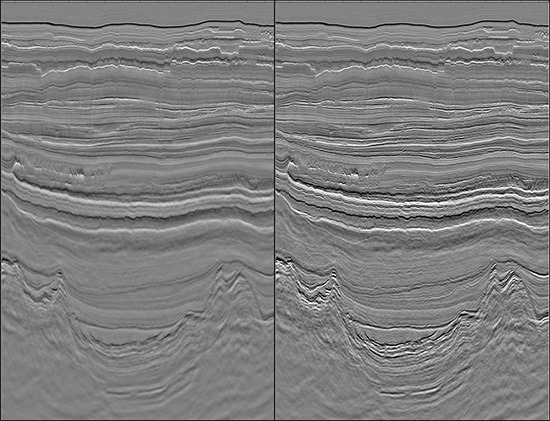Get the Most out of Broadband Seismic by Taming Attenuation
Paris, France | Jun 2, 2016
Q tomography and Q-compensating migration prove to be essential components of the broadband imaging toolbox.
All seismic signals naturally undergo attenuation during transmission through the Earth. The effect is generally stronger the longer the distance travelled. By the same virtue, higher frequencies are affected more than lower frequencies, as a greater number of wave cycles occur along the same travel path. This leads to low-frequency components dominating the amplitude spectrum at long offsets and for deep events. The overall effect is a broadening of the wavelet and deterioration of resolution in the deep section. The strength of the attenuation, denoted by the quality factor Q, also depends on the type of geology encountered.
Certain geological features, particularly shallow gas and gas hydrates, can have a remarkably drastic effect. Extreme cases can cause seismically obscured areas where attenuation effects degrade the quality of the seismic image to such an extent that events below those features are no longer interpretable. This can result in vital reservoir structures remaining unimaged.
The computation and application of compensation for such attenuation effects as part of seismic data processing is well established. Historically, simple 1D Q compensation filters were applied, while more recently the use of Q tomography and Q-compensating migration have extended the technique to include 3D variations which also take offset and raypath into account. With a tomographic approach it is possible to compensate for both the regional background trend and any strong localized attenuation anomalies.
With the introduction of broadband marine towed-streamer techniques which enable deghosting of the data, previous practical limitations due to the related spectral notches have been removed and the usable marine seismic bandwidth has been expanded significantly (up to 2.5 – 200 Hz). This makes frequency-dependent attenuation effects more apparent. Thus, Q tomography and Q-compensating migration now form an essential part of the broadband toolbox to restore the resolution of the data where impacted by attenuation.
CGG has developed a Q imaging toolbox over the last seven years which includes volumetric Q tomography based on a frequency peak shift approach and various Q-compensating depth migration algorithms (Q-PSDM), including Kirchhoff and TTI reverse time migration. We have published a range of examples from around the world which highlight some of the main applications of these techniques: imaging through gas pockets and delineating shallow geohazards in South East Asia; enhancing resolution on the North West Shelf of Australia and in the North Sea.
We are proud to say that one of these papers, "Unlocking the full potential of broadband data with advanced processing technology, a case study from NWS Australia", co-authored with Shell and presented at the 77th EAGE Conference & Exhibition in Madrid last year, has earned the presenter and lead author, Joe Zhou, the EAGE 2016 Guido Bonarelli Award for best oral presentation.
To learn how we are continuing to push the boundaries of Q tomography and Q-compensating migration for broadband data, do not miss this afternoon’s Technical Session paper (Th STZ0 10) on the Martin Linge case study being presented by Fatiha Gamar-Sadat at 13.55 in Room Stolz 0.






